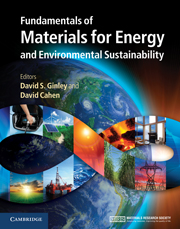Book contents
- Frontmatter
- Contents
- Contributors
- Preface
- Acknowledgments
- Part 1 Energy and the environment: the global landscape
- Part 2 Nonrenewable energy sources
- Part 3 Renewable energy sources
- Part 4 Transportation
- Part 5 Energy efficiency
- Part 6 Energy storage, high-penetration renewables, and grid stabilization
- 42 Toward the smart grid: the US as a case study
- 43 Consequences of high-penetration renewables
- 44 Electrochemical energy storage: batteries and capacitors
- 45 Mechanical energy storage: pumped hydro, CAES, flywheels
- 46 Fuel cells
- 47 Solar fuels
- 48 Solar thermal routes to fuel
- 49 Photoelectrochemistry and hybrid solar conversion
- Summary
- Appendix A Thermodynamics
- Appendix B Electrochemistry
- Appendix C Units
- Index
- References
47 - Solar fuels
from Part 6 - Energy storage, high-penetration renewables, and grid stabilization
Published online by Cambridge University Press: 05 June 2012
- Frontmatter
- Contents
- Contributors
- Preface
- Acknowledgments
- Part 1 Energy and the environment: the global landscape
- Part 2 Nonrenewable energy sources
- Part 3 Renewable energy sources
- Part 4 Transportation
- Part 5 Energy efficiency
- Part 6 Energy storage, high-penetration renewables, and grid stabilization
- 42 Toward the smart grid: the US as a case study
- 43 Consequences of high-penetration renewables
- 44 Electrochemical energy storage: batteries and capacitors
- 45 Mechanical energy storage: pumped hydro, CAES, flywheels
- 46 Fuel cells
- 47 Solar fuels
- 48 Solar thermal routes to fuel
- 49 Photoelectrochemistry and hybrid solar conversion
- Summary
- Appendix A Thermodynamics
- Appendix B Electrochemistry
- Appendix C Units
- Index
- References
Summary
Focus
Solar fuels are substances that store solar energy in the form of usable chemical energy. For them to be appropriate substances have to meet various requirements, which include the ability for their efficient production, sufficient energy density, and flexible conversion into heat, electrical, or mechanical energy. An essential requisite is environmental friendliness in order to sustainably incorporate conversion products into the global circulation of matter of the biosphere. This can be fulfilled now only by H2 and to some extent by some carbohydrates directly or indirectly produced by a solar energy source. Direct conversion of solar energy into free chemical energy – either by hydrogen or by hydrocarbon production – requires the development of efficient catalysts for the oxidation of water. This represents a huge materials design challenge, because multiple requirements for catalyst materials must be addressed simultaneously. After an introduction concerning the materials requirements for solar fuel production, storage, transport, and consumption, this chapter focuses on the topic of water-oxidation catalysis: what we can we learn from evolution for the development of an artificial oxygen-evolution center?
Synopsis
Solar fuels are substances that store solar energy as usable chemical energy at rates that allow sustainable conversion into other forms of energy. Oxidation of water driven by solar light, in order to gain a proton source for either hydrogen or hydrocarbon formation, seems to be the key issue. There are three fundamental steps in the conversion of solar energy into chemical energy (the first two of which also apply to the conversion of solar energy into electrical energy in photovoltaic cells; see Chapter 18). The first is light capture – absorbing the sunlight and transforming it into chemical energy of excited electron–hole pairs. The second is electron and hole transfer – separating and transporting sunlight-excited electrons and holes from their original sites in order to use them. The third is catalysis – the efficient generation and breaking of chemical bonds using the electrons and holes produced in this process to reduce and oxidize compounds, respectively. Although much progress has been made in catalytic control of reaction paths for the production of hydrocarbon and ammonia compounds, detailed understanding of the atomic processes occurring at catalysts and materials design of highly active and specific catalysts are still in their early stages. Here, the outstanding problem is the control of multielectron-transfer reactions, such as the evolution of oxygen from water, which requires four electrons for the liberation of one molecule of oxygen. Thermodynamics promise an energetically most favorable possibility for the oxidation of water when all four electrons are extracted in a correlated way with a minimum identical energy input (1.23 eV). Multielectron transfer requires a well-balanced coordinated chemical reaction involving multiple electron transfers through a sufficiently complex reacting chemical catalyst.
- Type
- Chapter
- Information
- Publisher: Cambridge University PressPrint publication year: 2011
References
- 2
- Cited by



